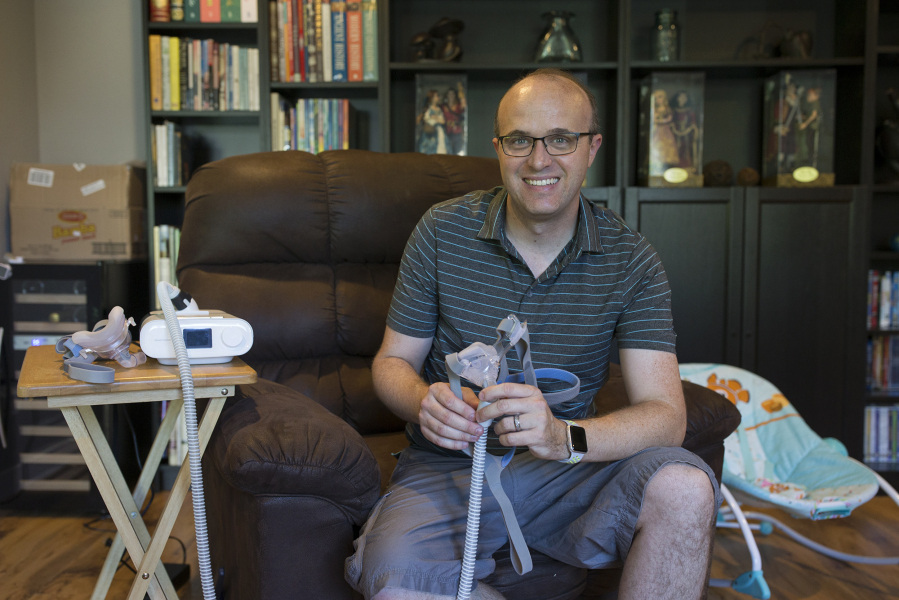At first, Jim Mains attributed his sleepless nights to having a newborn. Then, as work got busier, he pointed to the mounting stress as the reason for his lack of energy.
But when his wife, Ceci, voiced concerns about his increasing snoring and pauses in breathing during his sleep, the Vancouver man realized it was time to see a doctor. He was shocked by the diagnosis.
“I never suspected sleep apnea,” Mains said.
Sleep apnea is a sleep disorder in which breathing repeatedly stops and starts. The most common form of sleep apnea is obstructive apnea, which occurs when the throat muscles relax and obstruct the airways. It affects about 4 percent of men, 2 percent of pre-menopausal women and 4 percent of post-menopausal women, said Dr. Marlene Dietrich, medical director of the PeaceHealth Southwest Medical Center sleep lab.
People with untreated sleep apnea are at higher risk for high blood pressure, heart disease, stroke, memory problems or other cognitive issues, irritability and morning headaches, Dietrich said. The most common signs of sleep apnea are loud snoring, startling awake with a snort or gasp, breathing pauses during sleep and excessive sleepiness during the day, she said.
“If they think they’re getting adequate hours of sleep at night, but they’re waking up tired, that’s a tip-off,” Dietrich said.
Mains later realized he was experiencing all of the signs of sleep apnea, but at the time, he was unaware of the signs.
“A lot of people probably have sleep apnea and just think this is how it is,” Mains said.
Snoring worsens
Mains had always snored a little bit, usually tied to seasonal changes in the spring and fall. But after his son was born in February 2016, the snoring become more frequent. He was also waking up more throughout the night and not sleeping as much — things he attributed to having a newborn.
But then unusual things started to happen.
Mains started having what he thought were anxiety attacks in the middle of the night. Strange dreams would wake him up almost nightly between 2 and 4 a.m. with his heart pounding and his mind racing. He’d pace the house for hours, unable to fall back asleep.
Ceci Mains also started noticing that her husband would have periods in his sleep where it appeared as though he had stopped breathing. By that fall, Mains was starting to feel off. He didn’t have any energy. He didn’t want to do activities he used to enjoy. He mentioned it to his doctor, who ran some tests and blood work but couldn’t find anything wrong.
He went back to the doctor again in December. This time, though, he mentioned the snoring. Mains’ doctor, suspecting apnea, referred him to a sleep doctor.
In January, Mains did an at-home sleep test to confirm the diagnosis. That night, Mains felt like he got a really good night of sleep. He was shocked when his doctor told him the results of the sleep test. He stopped breathing an average of eight times per hour. His oxygen saturation levels dropped into the 80s twice during the night.
For a sleep apnea diagnosis, doctors are looking for at least five events of stopped breathing per hour and dropping oxygen levels, Dietrich said.
“We have seen people with over 100 (events), and you wonder, ‘How are these people even sleeping?’ ” Dietrich said. “All night long, your sleep is being disrupted with these apneas.”
Treatment options
Sleep apnea can be treated several ways. Some people with positional apnea — they only have it while lying on their back — can be treated with devices that prevent them from rolling to their backs. Those with mild to moderate apnea may be successfully treated with a dental appliance that pulls the lower jaw forward, preventing obstructions of the airway, Dietrich said.
For many, a continuous positive airway pressure, or CPAP, device is the course of treatment. That’s true for Mains.
The machine delivers continuous air into Mains’ nose through a tube attached to a mask he wears every night. With the machine, Mains still has periods where he stops breathing. But, rather than seven to eight times an hour, it’s down to one or two times. He sleeps better, falling asleep quickly and staying asleep. He’s even getting eight to nine hours of sleep each night.
“That’s amazing,” Mains said. “Before I would be happy to get five to six hours.”
He’s also no longer taking naps during the day and has energy. His blood pressure, which had been high, is now in the normal range and he’s not as forgetful. The extra energy has motivated Mains to get active again. He’s taking nightly walks and is trying to get back into jogging.
Dietrich urges anyone experiencing symptoms to talk with their doctor. Too often, she said, she hears from patients who have been ignoring signs for months.
“When they realize how much better they can feel, they wish they would’ve done it sooner,” she said.




